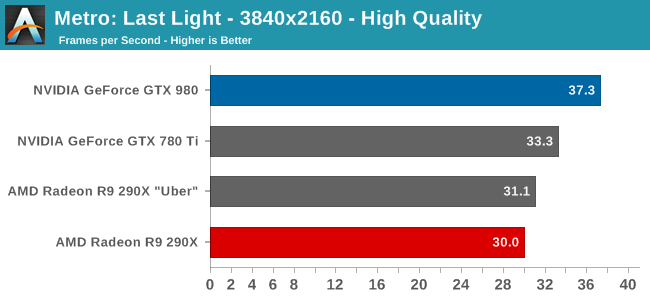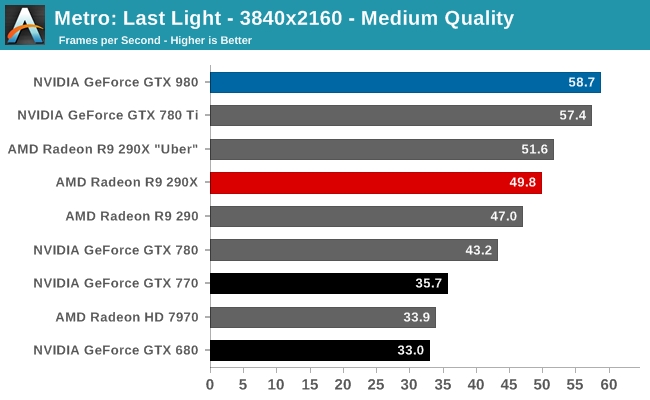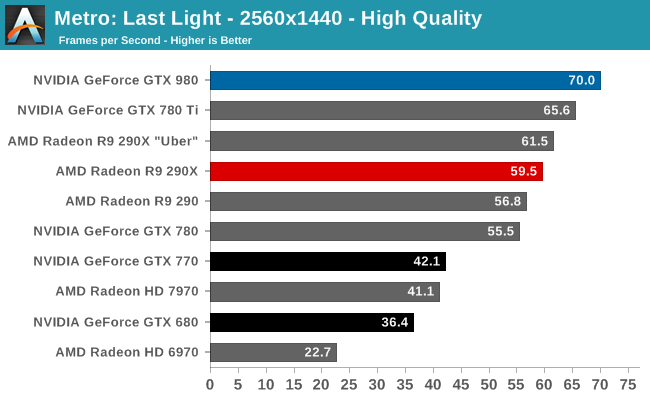The NVIDIA GeForce GTX 980 Review: Maxwell Mark 2
by Ryan Smith on September 18, 2014 10:30 PM ESTMetro: Last Light
As always, kicking off our look at performance is 4A Games’ latest entry in their Metro series of subterranean shooters, Metro: Last Light. The original Metro: 2033 was a graphically punishing game for its time and Metro: Last Light is in its own right too. On the other hand it scales well with resolution and quality settings, so it’s still playable on lower end hardware.




As has become customary for us for the last couple of high-end video card reviews, we’re going to be running all of our 4K video card benchmarks at both high quality and at a lower quality level. In practice not even GTX 980 is going to be fast enough to comfortably play most of these games at 3840x2160 with everything cranked up – that is going to be multi-GPU territory – so for that reason we’re including a lower quality setting to showcase just what performance looks like at settings more realistic for a single GPU.
GTX 980 comes out swinging in our first set of benchmarks. If there was any doubt that it could surpass the likes of R9 290XU and GTX 780 Ti, then this first benchmark is a great place to set those doubts to rest. At all resolutions and quality settings it comes out on top, surpassing NVIDIA’s former consumer flagship by anywhere from a few percent to 12% at 4K with high quality settings. Otherwise against the R9 290XU it’s a consistent 13% lead at 2560 and 4K Medium.
In absolute terms this is enough performance to keep its average framerates well over 60fps at 2560, and even at 3840 Medium it comes just short of crossing the 60fps mark. High quality mode will take the wind out of GTX 980’s sails though, pushing framerates back into the borderline 30fps range.
Looking at NVIDIA’s last-generation parts for a moment, the performance gains over the lower tier GK110 based GTX 780 are around 25-35%. This is about where you’d expect to see a new GTX x80 card given NVIDIA’s quasi-regular 2 year performance upgrade cadence. And when extended out to a full 2 years, the performance advantage over GTX 680 is anywhere between 60% and 92% depending on the resolution we’re looking at. NVIDIA proclaims that GTX 980 will achieve 2x the performance per watt of GTX 680, and since GTX 980 is designed to operate at a lower TDP than GTX 680, as we can see it means performance over GTX 680 won’t quite be doubled in most cases.










274 Comments
View All Comments
nathanddrews - Friday, September 19, 2014 - link
http://www.pcper.com/files/review/2014-09-18/power...kron123456789 - Friday, September 19, 2014 - link
Different tests, different results. That's nothing new.kron123456789 - Friday, September 19, 2014 - link
But, i still think that Nvidia isn't understated TDP of the 980 and 970.Friendly0Fire - Friday, September 19, 2014 - link
Misleading. If a card pumps out more frames (which the 980 most certainly does), it's going to drive up requirements for every other part of the system, AND it's going to obviously draw its maximum possible power. If you were to lock the framerate to a fixed value that all GPUs could reach the power savings would be more evident.Also, TDP is the heat generation, as has been said earlier here, which is correlated but not equal to power draw. Heat is waste energy, so the less heat you put out the more energy you actually use to work. All this means is that (surprise surprise) the Maxwell 2 cards are a lot more efficient than AMD's GCN.
shtldr - Wednesday, September 24, 2014 - link
"TDP is the heat generation, as has been said earlier here, which is correlated but not equal to power draw."The GPU is a system which consumes energy. Since the GPU does not use that energy to create mass (materialization) or chemical bonds (battery), where the energy goes is easily observed from the outside.
1) waste heat
2) moving air mass through the heatsink (fan)
3) signalling over connects (PCIe and monitor cable)
4) EM waves
5) degradation/burning out of card's components (GPU silicon damage, fan bearing wear etc.)
And that's it. The 1) is very dominant compared to the rest. There's no "hidden" work being done by the card. It would be against the law of conservation of energy (which is still valid, as far as I know).
Frenetic Pony - Friday, September 19, 2014 - link
That's a misunderstanding of what TDP has to do with desktop cards. Now for mobile stuff, that's great. But the bottlenecks for "Maxwell 2" isn't in TDP, it's in clockspeeds. Meaning the efficiency argument is useless if the end user doesn't care.Now, for certain fields the end user cares very much. Miners have apparently all moved onto ASIC stuff, but for other compute workloads any end user is going to choose NVIDIA currently, just to save on their electricity bill. For the consumer end user, TDP doesn't matter nearly as much unless you're really "Green" conscious or something. In that case AMD's 1 year old 290x competes on price for performance, and whatever AMD's update is it will do better.
It's hardly a death knell of AMD, not the best thing considering they were just outclassed for corporate type compute work. But for your typical consumer end user they aren't going to see any difference unless they're a fanboy one way or another, and why bother going after a strongly biased market like that?
pendantry - Friday, September 19, 2014 - link
While it's a fair argument that unless you're environmentally inclined the energy savings from lower TDP don't matter, I'd say a lot more people do care about reduced noise and heat. People generally might not care about saving $30 a year on their electricity bill, but why would you choose a hotter noisier component when there's no price or performance benefit to that choice.AMD GPUs now mirror the CPU situation where you can get close to performance parity if you're willing to accept a fairly large (~100W) power increase. Without heavy price incentives it's hard to convince the consumer to tolerate what is jokingly termed the "space heater" or "wind turbine" inconvenience that the AMD product presents.
Laststop311 - Friday, September 19, 2014 - link
actually the gpu's from amd do not mirror the cpu situation at all. amd' fx 9xxx with the huge tdp and all gets so outperformed by even the i7-4790k on almost everything and the 8 core i7-5960x obliterates it in everything, the performance of it's cpu's are NOT close to intels performance even with 100 extra watts. At least with the GPU's the performance is close to nvidias even if the power usage is not.TLDR amd's gpu situation does not mirror is cpu situation. cpu situation is far worse.
Laststop311 - Friday, September 19, 2014 - link
I as a consumer greatly care about the efficinecy and tdp and heat and noise not just the performance. I do not like hearing my PC. I switched to all noctua fans, all ssd storage, and platinum rated psu that only turns on its fan over 500 watts load. The only noise coming from my PC is my radeon 5870 card basically. So the fact this GPU is super quiet means no matter what amd does performance wise if it cant keep up noise wise they lose a sale with me as i'm sure many others.And im not a fanboy of either company i chose the 5870 over the gtx 480 when nvidia botched that card and made it a loud hot behemoth. And i'll just as quickly ditch amd for nvidia for the same reason.
Kvaern - Friday, September 19, 2014 - link
"For the consumer end user, TDP doesn't matter nearly as much unless you're really "Green""Or live in a country where taxes make up 75% of your power bill \